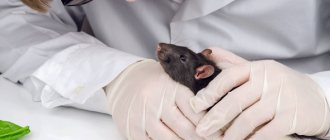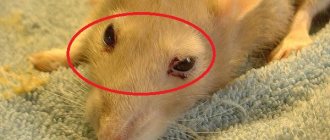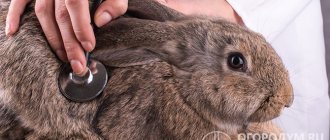According to statistics, from 50 to 60% of decorative rats are asymptomatic carriers of mycoplasmosis. Clinical signs in the form of damage to the respiratory system may appear with decreased immunity, dietary errors, hormonal or age-related changes.
And since complications of mycoplasmosis in rats lead to death, it is important to know the main symptoms of this pathology and begin proper treatment in a timely manner.
What kind of illness is this?
Mycoplasmosis in rats is a fairly common infectious disease of various rodents. Often, unfortunately, the disease leads to the death of the animal. This disease is caused by the bacterium Mycoplasma pulmonis. The surprising thing is that it is very difficult to find a rat that is not its carrier. Most often, this disease affects old individuals, as well as rats with weakened immune systems that were kept in improper or uncomfortable conditions. This disease can be transmitted by air, from animal to animal in direct contact, as well as from a person who has previously interacted with a sick rodent.
Can mycoplasma bacteria be transmitted to humans or infect other animals?
The owner of a sick pet should not worry about his own safety - the bacteria that provoke the disease in rats are not dangerous to humans. In total, science knows more than 30 varieties of mycoplasma bacteria, of which 6 species are pathogenic for humans. Rat mycoplasmas are not one of them (unlike mouse mycoplasmas).
A sick rat cannot infect animals of other species either, but it can easily infect its relatives. Therefore, if several rats live in a house and one of them is sick, it should be immediately isolated, otherwise the rest of the rats will also get sick.
Stages of the disease and their brief description
There are two stages of mycoplasmosis in rats. The first is latent. That is, the rodent did not show any clinical signs. The rat behaves like an absolutely healthy animal. In this case, the disease can only be determined using laboratory tests (PCR and ELISA). In the latent stage of mycoplasmosis, treatment is not applied. In this case, probiotics and vitamins are usually used. You should carefully care for your pet and keep its cage clean. If you keep the animal clean and feed it in a balanced manner, there is a high probability that the disease will not progress to the next stage.
At the second stage, the pet already shows clinical signs. Skin lesions and itching may be noticeable. Cough and rhinitis may also occur.
Is it possible to cure a pet and how to do it
It is important to recognize the disease as early as possible, since effective treatment of mycoplasmosis in rats is possible only at the initial stage of infection. That is why, when you notice the first alarming symptoms in your pet, you should contact a veterinarian.
The condition of the sick rat, without treatment, is getting worse every day. The longer veterinary help does not arrive, the less chance the animal has of salvation and the higher the likelihood of death.
The adaptation period of the disease is on average 2 weeks, but can reach up to 2 months. It is impossible to cure an animal in a short time. When trying to speed up therapy, the disease is modified into a chronic form.
The treatment of mycoplasma infection in decorative rats is based on the use of antibacterial medications. Only a veterinarian should prescribe a specific drug, as well as determine the dosage, schedule and method of administration. Selecting a medicine on your own can not only harm your pet, but also kill it, since many antibiotics for rats are prohibited (for example, penicillin).
In some cases, if there are corresponding symptoms or complications, the veterinarian will prescribe:
- hormonal drugs - corticosteroids;
- bronchodilators;
- diuretics;
- oxygen therapy.
To increase immunity and maintain a weakened body, a sick animal is given a decoction of echinacea to drink. After a course of antibiotics, the animal is given probiotics, otherwise the rodent will have problems with the gastrointestinal tract.
Symptoms of the disease in rodents. How to recognize the disease?
How can you tell if your pet is sick? What are the known symptoms of mycoplasmosis in rats? Experts say that diagnosing the disease is quite easy, since it has characteristic and pronounced signs that are quite difficult to confuse with the symptoms of other diseases. So, first, a rodent that has contracted mycoplasmosis begins to sneeze. While breathing, you can hear wheezing. The rat's fur becomes dull, unkempt and disheveled. In this case, the animal completely loses any interest in food.
In addition to external signs, there are also internal symptoms of respiratory mycoplasmosis in rats and mice. One of the main internal ones is the appearance of a large number of abscesses and blisters on the surface of the lungs. This very often leads to the development of pneumonia. In addition, because of this, females can develop infectious processes in the uterus. There are other characteristic symptoms of mycoplasmosis in rats. For example, discharge (porphyrin) can be observed from the animal's nose and eyes. If the female's internal organs are affected, bloody discharge from the genitals may appear. Every day the animal's condition will worsen; without qualified veterinary care, the rodent may die due to damage to internal organs or from an attack of suffocation.
It is very important to recognize the disease in the early stages, before the animal is in critical condition. Then he can still be helped. However, if the disease progresses, no treatment is prescribed, and the rodent’s condition is aggravated by a deficiency of vitamins, ammonia vapor in a dirty cage, cigarette smoke, etc., then the outcome is a foregone conclusion. Is it possible to get mycoplasmosis from a rat? No. This disease is not transmitted from rodents to humans. Therefore, be calm about yourself, if your pet is sick, it is better to think about him, as he needs prompt treatment.
Diagnostics
Despite the fact that the symptoms of the disease were discussed above, a doctor should make an accurate diagnosis, since the signs of the disease can be confused with signs of allergies or other ailments. Moreover, given the high metabolic activity of mycoplasmosis in rats, as well as the high risk of contracting a secondary infection, you should not postpone a visit to the veterinarian for too long. The sooner the doctor examines the rodent and prescribes the necessary examinations, the sooner a diagnosis will be made and treatment will be prescribed.
How to correctly diagnose the disease
The symptoms of mycoplasma infection are pronounced and unique, which prevents this disease from being confused with other ailments, and also makes it possible to quickly and easily diagnose it. However, only a veterinarian should make a diagnosis - independent “amateur” diagnosis is fraught with error and, as a result, reducing the chances of healing the animal.
To determine the diagnosis, the veterinarian will conduct a comprehensive examination of the rodent, since some symptoms of mycoplasmosis coincide with the manifestations of other diseases:
- sneezing and itchy skin – with allergies, mite infestation, etc.;
- impaired coordination of movements - with brain lesions, neoplasms, etc.
The veterinarian will not only examine the rat, but will also do the tests necessary to make an accurate diagnosis (laboratory studies of mucous membranes, etc.).
Treatment of rats
Treatment should be prescribed for mycoplasmosis in rats. As a rule, antibiotics are used in this case. However, how to take them and in what dosage must be determined by a veterinarian, since not all antibiotics are approved for rodents. If we talk about approved drugs, these include the drugs Doxycycline and Gentamicin. Among the veterinary drugs used in this case are Tylosin or Baytril, as well as derivatives of these drugs.
Penicillin antibiotics are strictly prohibited for rats. These drugs can cause anaphylactic shock and lead to the death of the animal.
If the disease is in an early stage and is immediately identified, then a drug such as “Tsiprolet” is prescribed. When a young individual with a weakened immune system falls ill, antibiotics from the cephalosporin series are usually used. It could be Cephalexin. Echinacea will help in the fight against the disease and will also enhance the effect of the drugs. To do this, buy this herb at the pharmacy, brew it and feed the resulting decoction to the rodent. You should drink the infusion for several days throughout the week.
If you are looking for the most effective way to use medications, then this is, of course, injections. Giving a rat an injection is, of course, not at all easy. Subcutaneous injections are given into the neck fold. Intramuscular injections need to be injected into the muscles of the hind legs. It is best to give injections with a thin insulin syringe. When the manipulation is carried out, another person will be required to hold the rodent. Do not forget that after the course of antibiotics is completed, your pet must be given probiotics.
Causes of the disease
The main cause of mycoplasmosis is single-celled microorganisms - mycoplasmas. Pathogenic microflora enters the animal's body through airborne droplets or contact (through food, water, dirty bedding). The disease can also be transmitted vertically - during childbirth from mother rats to pups.
For a long time, mycoplasma can remain in the body in a “dormant” state. There are several unfavorable factors that can provoke the activation of pathogenic microorganisms:
- frequent stressful situations - change of place of residence, moving new neighbors into a cage, long-term departure of the owner (on vacation or business trip);
- poor-quality nutrition - a diet containing an insufficient amount of useful micro- and macroelements, as well as the consumption of forbidden foods (sweets, sausages, cheese, smoked meats, fatty meats, pickles);
- negative environmental factors - increased background radiation, heavy dust or smoke in the air, high noise pollution;
- intoxication , for example, by eating plants that are poisonous to rats (aloe, tulips, dieffenbachia, daffodils) or by inhaling tobacco smoke;
- keeping an animal in unsanitary conditions;
- presence of concomitant infectious diseases;
- serious injuries received from a fall, during a fight with relatives or after meeting with other pets;
- allergy.
It has also been established that age also affects the likelihood of developing mycoplasmosis. After 2 years, a rat runs a 50% higher risk of contracting a respiratory infection than a young rat. While the survival rate of older individuals is significantly lower.
Mycoplasmosis in rats. Caring for a Sick Rat
For the treatment to be most effective, you need to properly care for the sick animal. A number of activities should be carried out that will contribute to the rapid recovery of the pet. It is necessary to do a general cleaning, while disinfecting the pet’s cage. The air in the room in which you will keep your pet should not be too humid, but not too dry. During the treatment period, it is worth cleaning the cage daily, as the smell of ammonia irritates the nasal passages, resulting in increased secretions. If the rat begins to freeze, you can place a warm heating pad next to it. If you keep two rodents, then if symptoms are detected, you should isolate the healthy individual in a separate cage.
References
- Plakhova, K.I. Clinical significance of genetic variability of genital mycoplasmas. – Bulletin of Dermatology and Venereology, 2015. – No. 2. — P.76-83.
- Savicheva A.M., Shpitsina, E.V. Genital mycoplasmas. - Doctor, 2009. - No. 1. — P.9-12.
- Federal clinical guidelines for the management of patients with urogenital diseases caused by Ureaplasma spp., Mycoplasma Hominis; Moscow, 2015. - 24 p.
- Dessi, D., Margarita, V., Cocco, A. et al. Trichomonas vaginalis and Mycoplasma hominis: new tales of two old friends. - Parasitology, 2021. - Vol. 146(9). — P. 1150-1155.
Caring for a rat after illness
Even after you have cured the animal, it needs special care. The most basic thing you need to do is fatten the rodent. Since during his illness he most likely lost a lot of weight.
Include high-calorie foods in your rat's diet. During the recovery period, you can give your pet baby formula and purees. At the same time, protect your animal from cold and drafts. Make sure that the rodent does not catch any infection, since its immunity is now very weak.
Prevention of disease in rodents
What should be the prevention of mycoplasmosis in rats? What should you do to avoid infection? Please note that it is not possible to completely protect your pet from infection. You can only reduce the risk of its occurrence. So what should you do? It is necessary to ensure that the animal’s diet is balanced and complete. At the same time, the conditions in which he lives should be as comfortable as possible for the rodent. Contact of your pet with sick rodents should be avoided.
Before handling your rat, be sure to wash your hands with soap and water. This procedure can also be carried out after contact with a rodent. If you follow these recommendations, you will be able to reduce your risk of contracting this infectious disease.
Preventive actions
There is no protection against mycoplasma infection. The only thing the owner of a pet rat can do is try to minimize the risk of disease. Measures that will help achieve this include the following:
- Providing a complete and balanced diet (including feeding with vitamins).
- Creation and maintenance of optimal comfortable living conditions.
- Avoid contact between your pet and sick animals.
- Maintaining hygiene (regular cleaning of the animal’s cage, etc.).
It would also be a good idea to wash your hands every time before touching your pet, just in case. As you know, preventing a disease is easier than curing it.











